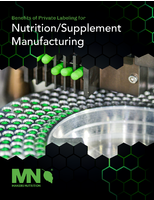General-Purpose Adhesive/Sealant features tin-free formula.
Press Release Summary:
Intended for household appliance, automotive, and electronics sectors, ELASTOSIL® N9111 single-component silicone rubber compound cures at room temperature in presence of atmospheric moisture to yield silicone with optimized heat resistance and mechanical properties. This alkoxy-curing RTV-1 system, formulated with tin-free catalyst, is fully compatible with platinum-catalyzed silicone products, even in uncured state. Cured rubber is resistant to UV light and temperatures up to 200°C.
Original Press Release:
WACKER Develops Tin-Free, General-Purpose Adhesive Sealant for the Automotive, Household Appliance and Electronic Industry Sectors
Munich - Munich-based chemical company WACKER has developed a new general-purpose adhesive and sealant for the household appliances, automotive and electronics sectors. Available under the name ELASTOSIL® N9111, the one-component silicone rubber compound is a tinfree formulation. It cures at room temperature in the presence of atmospheric moisture to yield a silicone which has excellent heat resistance and good mechanical properties. The new adhesive constitutes a tin-free alternative to conventional roomtemperature-curing, one-component silicone rubber compounds.
RTV-1 silicone grades are widely used in bonding, sealing and coating applications. They have become indispensable in many industrial sectors, including construction, automotive engineering, household appliances, electronics and textiles.
The launch of ELASTOSIL® N 9111 extends the Munich-based chemical company's range of condensation-curing silicone rubber compounds with a product which offers new processing opportunities in the electronics and household appliances sectors. The new adhesive sealant, technically an alkoxy-curing RTV-1 system, is formulated with a tin-free catalyst. It is therefore ideal for applications in which organo-tin compounds act as inhibitors and are therefore undesirable.
For instance, ELASTOSIL® N 9111 makes the dam-and-fill encapsulation of electronic modules significantly quicker and easier. In this process, a bead of non-sag silicone is applied to the module to create a dam around the encapsulation area, which is then filled with a lowviscosity encapsulant, e.g. a platinum-catalyzed silicone gel. If the RTV-1 silicone used for the bead contains a tin catalyst, the silicone must be fully cured before encapsulation. Otherwise the tin will inhibit the curing of the platinum-catalyzed encapsulant. As a result, using tin-based RTV-1 silicones for such procedures is always time consuming and cost intensive.
Unlike such conventional RTV-1 grades, the new ELASTOSIL® N 9111 is free of tin and thus fully compatible with platinum-catalyzed silicone products, even in an uncured state. Electronic devices can be encapsulated in silicone gel as soon as the bead has been applied. There is no need to worry about inhibition of the platinum-curing encapsulant.
ELASTOSIL® N 9111 therefore offers considerable time savings and processing advantages for manufacturers of electronic components for the automotive and other sectors. For instance, junction boxes for solar panels can be mounted faster and hence more cost effectively with ELASTOSIL® N 9111. They can be encapsulated with platinumcatalyzed silicone grades directly after the fixing step if they have been mounted with the aid of the new silicone adhesive. It is not necessary to wait a certain length of time in order to minimize the risk of inhibition of the platinum-catalyzed encapsulants by tin-based RTV-1 silicones.
Further applications for the new general-purpose adhesive include demanding bonding applications in the household appliances sector, e.g. bonding of ceramic hobs, screens and control panels in electric cookers. The new adhesive-sealant also enables reliable mounting and bonding of front windows of microwave ovens.
ELASTOSIL® N 9111 is a soft, non-sag paste. Its viscosity decreases when shear is applied. This "shear-thinning" enables the silicone rubber compound to be readily applied both manually and mechanically.
The material is available in black and white and adheres to many conventional substrates, such as aluminum, stainless steel, glass, polyamide and polyvinyl butyral. The cured rubber is resistant to both UV light and temperatures of up to 200 °C.
In many industrial sectors, electrical components require flexible bonding. Apart from bonding, the adhesive layer also acts as a sealant. WACKER has developed the new silicone adhesive sealant ELASTOSIL® N 9111 for applications where tin compounds could possibly be detrimental. ELASTOSIL® N 9111 is formulated without an organo-tin catalyst and is therefore compatible with addition-curing silicone products as well.
WACKERis a globally-active chemical company with some 16,300 employees and annual sales of around Euros4.75 billion (2010). WACKER has a global network of 26 production sites, 20 technical competence centers and 50 sales offices.
WACKER SILICONES
Silicone fluids, emulsions, rubber and resins; silanes; pyrogenic silicas; thermoplastic silicone elastomers
WACKER POLYMERS
Polyvinyl acetate and vinyl acetate copolymers in the form of dispersible polymer powders, dispersions, solid resins and their associated solutions used as binders for construction chemicals, paints and coatings, adhesives, plasters, textiles and nonwovens, as well as for polymeric materials based on renewable resources.
WACKER BIOSOLUTIONS
Biotech products such as cyclodextrins, cysteine and biologics, as well as fine chemicals and PVAc solid resins
WACKER POLYSILICON
Polysilicon for the semiconductor and photovoltaic industries
Siltronic
Hyperpure silicon wafers and monocrystals for semiconductor devices




